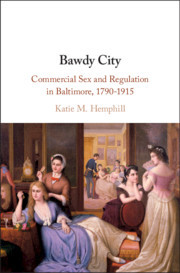Description
Bawdy City
Commercial Sex and Regulation in Baltimore, 1790–1915
Author: Hemphill Katie M.
Centering the experiences of women, this vivid social history examines Baltimore's prostitution trade and its evolution throughout the nineteenth century.
Language: English
Subject for Bawdy City:
Approximative price 30.28 €
In Print (Delivery period: 14 days).
Add to cart
Bawdy City
Publication date: 06-2022
Support: Print on demand
Publication date: 06-2022
Support: Print on demand
Approximative price 67.54 €
In Print (Delivery period: 14 days).
Add to cart
Bawdy City
Publication date: 01-2020
352 p. · 15.9x23.6 cm · Hardback
Publication date: 01-2020
352 p. · 15.9x23.6 cm · Hardback
Description
/li>Contents
/li>Biography
/li>
A vivid social history of Baltimore's prostitution trade and its evolution throughout the nineteenth century, Bawdy City centers women in a story of the relationship between sexuality, capitalism, and law. Beginning in the colonial period, prostitution was little more than a subsistence trade. However, by the 1840s, urban growth and changing patterns of household labor ushered in a booming brothel industry. The women who oversaw and labored within these brothels were economic agents surviving and thriving in an urban world hostile to their presence. With the rise of urban leisure industries and policing practices that spelled the end of sex establishments, the industry survived for only a few decades. Yet, even within this brief period, brothels and their residents altered the geographies, economy, and policies of Baltimore in profound ways. Hemphill's critical narrative of gender and labor shows how sexual commerce and debates over its regulation shaped an American city.
Introduction; Part I. The Rise of Prostitution in the Early Republic: 1. Selling sex in the early republic; 2. The expansion of prostitution and the rise of the brothel; 3. Brothel prostitution and antebellum urban commercial networks; Part II. Regulating and Policing the Sex Trade: 4. Policing the expanding sex trade; 5. 'Our patriotic friends': selling sex in the Civil War era; 6. Prostitution, policing, and property rights in the Gilded Age; Part III. Change and Decline in the Brothel Trade: 7. Black Baltimoreans and the bawdy trade; 8. Rise of urban leisure and the decline of brothels; 9. The end of an era; Conclusion.
Katie M. Hemphill is Assistant Professor of History at the University of Arizona.
© 2024 LAVOISIER S.A.S.

